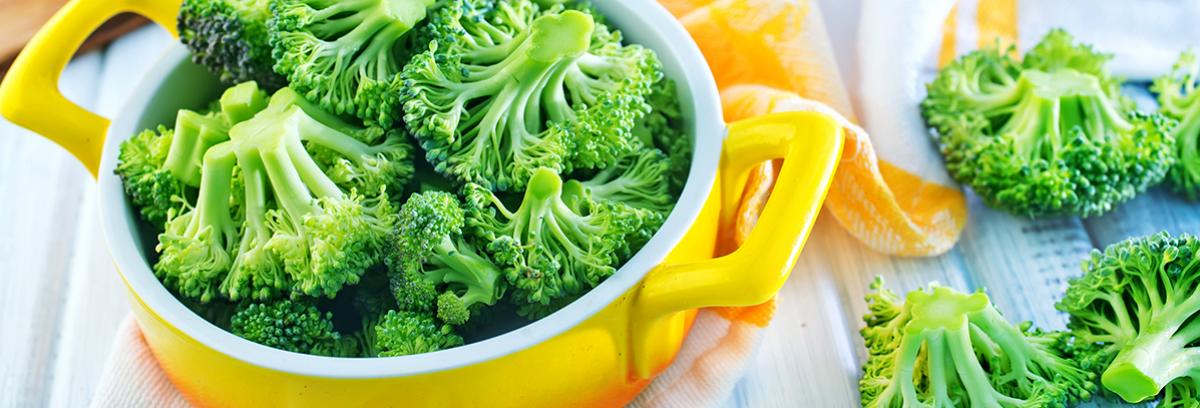
BUYING AND STORING BROCCOLI
January 24, 2021
|
8 min
ORIGIN
Broccoli, part of the cabbage family, is very similar to cauliflower. Discovered by the Greeks, it was very popular with the ancient Romans, in part as a “secret recipe” against hangovers following sessions of feasting and drinking. Up until the First World War it was also very popular in Germany, but was then forgotten about. Nowadays, however, broccoli has regained its place among the favourite vegetables in Germany. Like all forms of cabbage, it originally comes from the Asian part of Turkey, Anatolia. Within Europe, broccoli is mainly cultivated in Italy, Spain, France, Holland, England and Germany. It is therefore possible to grow it all year round.
INGREDIENTS AND NUTRITIONAL VALUES
Broccoli is easy to digest and contains especially high amounts of minerals including potassium, calcium, phosphorus and iron. Broccoli also contains lots of magnesium, which is important for muscle and heart performance, nerve impulse transmission and hormone production. It is especially rich in beta-carotene, niacin and vitamin C.
| Nutritional values | based on 200g uncooked weight, which corresponds to around one portion of vegetables on the side |
| Energy: | 52 kcal/216 kJ |
| Protein: | 6.6g |
| Fat: | 0.4g |
| Carbohydrate: | 5g |
| Fibre: | 6g (20% of the recommended daily intake of 30g) |
| Vitamin C: | 230mg (230%)* |
| Potassium: | 700mg (35%)* |
| Phosphorus: | 164mg (23%)* |
| Niacin: | 2.2mg (16%)* |
| Magnesium: | 48mg (15%)* |
| Calcium: | 116mg (12%)* |
| Iron: | 1.6mg (12%)* |
| Vitamin A: | 100 µg (11%)* |
| Vitamin E: |
1.2mg (9%)* |
Source: The large GU Nutritional Information table, 2006/07. The recommended daily intake amounts corresponds to the reference values for nutrient intake (2000) for an adult. * of the daily recommended intake

BUYING BROCCOLI
German broccoli is available from June to November. Short transportation distances ensure that it stays fresh. You can see this from its deep, green colour and the closed flowerheads. When buying broccoli, make sure that the little flowers have not yet opened and are not a yellow colour. Broccoli from the supermarket usually comes wrapped in plastic for freshness. It should stay in the plastic until you need to use it, because the plastic keeps the vegetables at the level of humidity they need to stay fresh, around 90 percent.
STORAGE
Broccoli is best when cooked straight after buying. If it is not going to be used straightaway, it should be kept in its plastic and stored somewhere cool and dry for up to two days (e.g. in the vegetable drawer of the fridge). This is because broccoli wilts quickly, in the process losing its valuable vitamins and minerals. Storing broccoli together with apples or oranges will make it turn yellow and lose its leaves, as these fruits emit the ripening gas ethylene. Broccoli is good for freezing, however. It should nonetheless be thoroughly washed before being frozen, because there will often be small insects hiding in the florets. It is then blanched, i.e. cooked in boiling water for around three minutes. Broccoli will then keep for up to ten months in a freezer.
COOKING WITH BROCCOLI
Broccoli’s greenish-bluish flower heads are a delicacy, likewise its stalks, which taste like asparagus. It is prepared in a similar way to cauliflower. When it is cooked as a single piece, a cross should be cut into the base of the stalk. This helps it to cook as quickly as the florets. Broccoli can be sautéed, steamed, or boiled – usually in small pieces; when cooked in lightly salted water it will be al dente in 10 to 12 minutes. This healthy vegetable is used mainly in bakes, soups, stews, sauces and salads. It is also a firm favourite as a light accompaniment to meat dishes, especially veal, poultry, pork and lamb. White wine, lemon juice or butter can further enhance its fine flavour, however strong spices will only overwhelm it.
PARTICULAR CHARACTERISTICS/NUTRITIONAL INFORMATION
Thanks to its high vitamin C content (one portion as a vegetable side dish provides 230mg of vitamin C), eating fresh broccoli is a good way of strengthening your immune system. In addition, broccoli provides a good supply of calcium. This is especially important for people who are dairy-intolerant and have to obtain their calcium from alternative food sources. Its low calorific content is worth noting: one 200g portion contains no more than 52 kcal and yet it provides a fifth of our guideline daily intake of fibre. Those who are looking to stay trim can therefore eat plenty of this vegetable – provided that it isn’t cooked with lots of fat – and, in doing so, rest assured that they are keeping their digestive systems working well. Broccoli is also well-suited to diabetics, since the fibre it contains helps the blood sugar level to remain constant for longer.